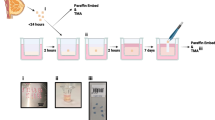Summary
The effect of the anti-estrogens ICI 164,384 and tamoxifen on the estradiol (E2) concentration after incubation of estrone sulfate (E1-S) with different hormone-dependent (MCF-7 and T-47D) and hormone-independent (MDA-MD-231 and MDA-MB-436) mammary cancer cells, as well as the estrone sulfatase activity in these various cell lines, are presented. The anti-estrogen ICI 164,384 decreased very significantly the concentration of E2 after incubation of E1-S with MCF-7 (control, mean ±SE: 100±24 pg/mg DNA; + ICI 164,384 [10−6M]: 7±2 pg/mg DNA). This effect was much more intense than with tamoxifen. A similar effect was observed with T-47D cells. However, no significant effect was observed in the hormone-independent cells. In the intact cell, estrone sulfatase activity was very intense in the hormone-dependent cells, but very small in the hormone-independent cells. However, this activity became very strong after homogenization in the hormone-independent cells. The data suggest that estrone sulfate can play an important role on the bioavailability of E2 in hormone-dependent breast cancer, and that understanding the control of estrone sulfatase activity can open new knowledge of the estrogen responses and new possibilities of therapeutic application in breast cancer.
Similar content being viewed by others
References
Pasqualini JR, Gelly C, Nguyen B-L, Vella C: Importance of estrogen sulfates in breast cancer. J Steroid Biochem 34: 155–163, 1989
Dao TL, Hayes C, Libby PR: Steroid sulfatase activities in human breast tumors. Proc Soc Expl Biol Med 146: 381–384, 1974
Tseng L, Mazella J, Lee L-Y, Stone ML: Estrogen sulfatase and estrogen sulfotransferase in human primary mammary carcinoma. J Steroid Biochem 19: 1413–1417, 1983
Hobkirk R: Steroid sulfotransferases and steroid sulfate sulfatases: characteristics and biological role. Can J Biochem Cell Biol 63: 1127–1144, 1985
Vignon F, Terqui M, Westley B, Derocq D, Rochefort H: Effects of plasma estrogen sulfates in mammary cancer cells. Endocrinology 106: 1079–1086, 1980
Pasqualini JR, Gelly C: Estrogen sulfates: biological and ultrastructural responses and metabolism in MCF-7 human breast cancer cells. Breast Cancer Res Treat 8: 233–240, 1986
Pasqualini JR, Gelly C, Lecerf F: Biological effects and morphological responses to estriol, estriol-3-sulfate, estriol-17-sulfate and tamoxifen in a tamoxifen-resistant cell line (R-27) derived from MCF-7 human breast cancer cells. Eur J Cancer Clin Oncol 22: 1495–1501, 1986
Pasqualini JR, Gelly C: Effect of tamoxifen and tamoxifen derivatives on the conversion of estrone sulfate to estradiol in the MCF-7 mammary cancer cell line. Cancer Lett 40: 115–121, 1988
Wakeling AE, Bowler J: Steroidal pure antiestrogens. J Endocr 112: R7-R10, 1987
Soule HD, Vasquez J, Long A, Albert S, Brennan M: A human cell line from pleural effusion derived from a breast carcinoma. J Natl Cancer Inst 51: 1409–1416, 1973
Keydar I, Chen L, Karby S, Weiss FR, Delarea J, Radu M, Chaitcik S, Brenner HJ: Establishment and characterization of a cell line of human breast carcinoma origin. Eur J Cancer 15: 659–670, 1979
Cailleau R, Olive M, Cruciger QVJ: Long-term human breast carcinoma cell lines of metastatic origin: preliminary characterization. In Vitro 14: 911–915, 1978
Burton K: A study of the conditions and mechanism of the diphenylamine reaction for the colorimetric estimation of deoxyribonucleic acid. Biochem J 62: 315–323, 1956
MacIndoe JH: The hydrolysis of estrone sulfate and dehydroepiandrosterone sulfate by MCF-7 human breast cancer cells. Endocrinology 123: 1281–1286, 1988
Prost O, Turrel MO, Dahan N, Craveur C, Adessi G: Estrone and dehydroepiandrosterone sulfatase activities and plasma estrone sulfate levels in human breast carcinoma. Cancer Res 44: 661–664, 1984
Samojlik E, Santen RJ, Worgul TJ: Plasma estrone sulfate assessment of reduced estrogen production during treatment of metastatic breast carcinoma. Steroids 39: 497–507, 1982
Wakeling AE: Comparative studies on the effects of steroidal and nonsteroidal oestrogen antagonists on the proliferation of human breast cancer cells. J Steroid Biochem 34: 183–188, 1989
Pasqualini JR, Gelly C: Biological response of the antiestrogen ICI 164,384 in human hormone-dependent and hormone-independent mammary cancer cell lines. Cancer Lett 50: 133–139, 1990
Author information
Authors and Affiliations
Rights and permissions
About this article
Cite this article
Pasqualini, J.R., Nguyen, BL. Estrone sulfatase activity and effect of antiestrogens on transformation of estrone sulfate in hormone-dependent vs. independent human breast cancer cell lines. Breast Cancer Res Tr 18, 93–98 (1991). https://doi.org/10.1007/BF01980971
Issue Date:
DOI: https://doi.org/10.1007/BF01980971




